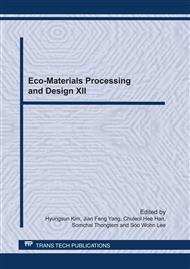p.9
p.13
p.17
p.21
p.25
p.29
p.33
p.37
p.41
Effects of Annealing Conditions on Morphology and Permeability of Palladium Membrane
Abstract:
The palladium membranes were fabricated by mean of electroless plating method which provided thin and uniform film on a tubular alumina porous support. Subsequently, the annealing process which is one of the effective ways to enhance the permeability of membrane was performed in the temperature range of 600-800°C. The annealing temperature and time were found to have influence on membrane microstructure and its performance. Palladium annealed at 700°C for 8 hrs in nitrogen atmosphere had the highest hydrogen permeability and separation factor when operated at 600°C. The membrane morphologies observed by SEM showed that the sample treated at higher temperature had lower surface roughness. The annealed palladium composite membrane at 800°C revealed that some voids which occurred during electroless plating process were enlarged and caused the lower separation factor.
Info:
Periodical:
Pages:
25-28
Citation:
Online since:
July 2011
Authors:
Price:
Сopyright:
© 2011 Trans Tech Publications Ltd. All Rights Reserved
Share:
Citation:


